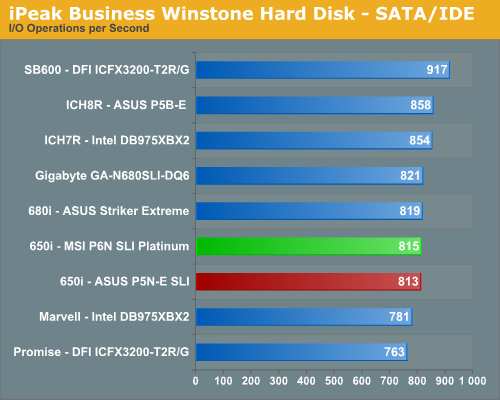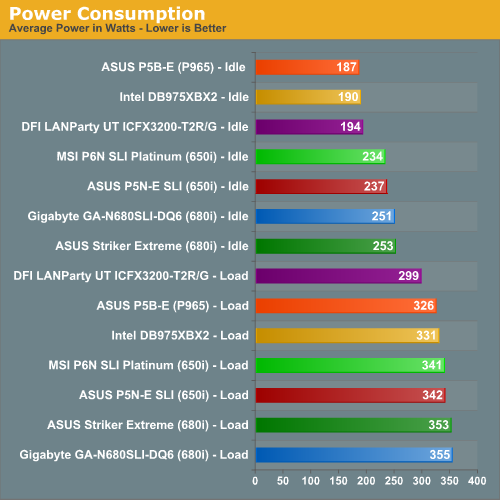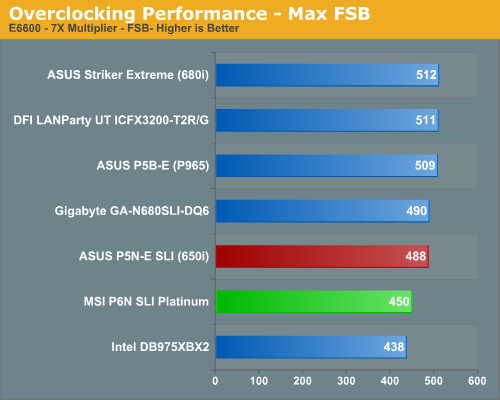MSI P6N SLI Platinum: NVIDIA's 650i Part Two
by Gary Key on March 13, 2007 1:00 AM EST- Posted in
- Motherboards
Disk Controller Performance
The AnandTech iPeak test is designed to measure "pure" hard disk controller performance, and in this case, we keep the hard drive as consistent as possible while varying the hard drive controller. The idea is to measure the performance of each hard drive controller with the same hard drive.
We played back our raw files that are recorded I/O operations when running a real world benchmark - the entire Winstone 2004 suite. Intel's iPeak utility was then used to play back the trace file of all I/O operations that took place during a single run of Business Winstone 2004 and MCC Winstone 2004. The drive is formatted before each test run and a composite average of three tests on each controller interface is tabulated in order to ensure consistency in the benchmark.
iPeak gives a mean service time in milliseconds; in other words, the average time that each drive took to fulfill each I/O operation. In order to make the data more understandable, we report the scores as an average number of I/O operations per second so that higher scores translate into better performance. This number is meaningless as far as hard disk performance is concerned, as it is just the number of I/O operations completed in a second. However, the scores are useful for comparing "pure" performance of the storage controllers in this case.


The performance patterns hold steady across both Multimedia Content I/O and Business I/O with the SB600 outperforming the Intel ICH7R, Intel ICH8R, and NVIDIA 680i/650i chipsets in our non-Raid tests. The Promise controller on the DFI board is the slowest of all solutions with the Marvell controller on the Intel 975X performing only slightly better. The 680i and 650i MCP chipsets are different but their disk performance in our tests is basically alike. We also ran RAID 0 and RAID 5 tests on each controller with the results being in favor of the 680i MCP by around 2%.
We did not witness any data corruption on our NVIDIA based boards as has been reported on the 680i reference boards, and we consider this problem to be fixed since our P23 BIOS update. We did have data corruption issues with the Gigabyte board when using 1T Command Rate at DDR2-800 with an early F2 beta BIOS but this was solved in the final F3 BIOS. Although our NVIDIA boards generally score lower in these "pure" throughput tests, we find their performance in disk intensive applications is generally better than the other solutions.
Power Consumption

Our power consumption numbers are based on our test setup for this article that consists of the MSI 8800GTX video card, and our boards have C1E/EIST turned off. The 680i leads all boards in power consumption and the 650i SLI is second though on average it still consumes about 7% less power than the 680i at idle and 3% at load. The P965 consumes the least amount of power at idle but around 10% more than the RD600 at load. The 975X still offers a decent level of power conservation compared to the other chipsets even though it is over two years old now.
Overclocking

As we mentioned earlier in the article, the overclocking capability of the MSI board has varied widely with each BIOS release we have tested. This will be disappointing to some users and we expected a little better overclocking capability based upon the quality of the board and its BIOS options. However, like most recent MSI boards we find they have generally implemented very aggressive memory and chipset timings at stock speeds at the expense of overclocking. This is generally true of the MSI P6N SLI Platinum but we have found it overclocks better than most of the MSI boards we have tested recently.
One area we found interesting is the MSI board experienced several FSB holes with the 1.22 BIOS that we witnessed on the 680i reference boards. We did experience the typical FSB hole around 416FSB and hit another one right around 460FSB and 500FSB in the latest BIOS. We also found that during overclocking we had to set our CPU voltages a little higher than on the other boards to attain the same overclocks. We have experienced this before with other MSI boards and it was due to tighter sub-timings in order to improve the performance of the board at stock speeds.
The AnandTech iPeak test is designed to measure "pure" hard disk controller performance, and in this case, we keep the hard drive as consistent as possible while varying the hard drive controller. The idea is to measure the performance of each hard drive controller with the same hard drive.
We played back our raw files that are recorded I/O operations when running a real world benchmark - the entire Winstone 2004 suite. Intel's iPeak utility was then used to play back the trace file of all I/O operations that took place during a single run of Business Winstone 2004 and MCC Winstone 2004. The drive is formatted before each test run and a composite average of three tests on each controller interface is tabulated in order to ensure consistency in the benchmark.
iPeak gives a mean service time in milliseconds; in other words, the average time that each drive took to fulfill each I/O operation. In order to make the data more understandable, we report the scores as an average number of I/O operations per second so that higher scores translate into better performance. This number is meaningless as far as hard disk performance is concerned, as it is just the number of I/O operations completed in a second. However, the scores are useful for comparing "pure" performance of the storage controllers in this case.


The performance patterns hold steady across both Multimedia Content I/O and Business I/O with the SB600 outperforming the Intel ICH7R, Intel ICH8R, and NVIDIA 680i/650i chipsets in our non-Raid tests. The Promise controller on the DFI board is the slowest of all solutions with the Marvell controller on the Intel 975X performing only slightly better. The 680i and 650i MCP chipsets are different but their disk performance in our tests is basically alike. We also ran RAID 0 and RAID 5 tests on each controller with the results being in favor of the 680i MCP by around 2%.
We did not witness any data corruption on our NVIDIA based boards as has been reported on the 680i reference boards, and we consider this problem to be fixed since our P23 BIOS update. We did have data corruption issues with the Gigabyte board when using 1T Command Rate at DDR2-800 with an early F2 beta BIOS but this was solved in the final F3 BIOS. Although our NVIDIA boards generally score lower in these "pure" throughput tests, we find their performance in disk intensive applications is generally better than the other solutions.
Power Consumption

Our power consumption numbers are based on our test setup for this article that consists of the MSI 8800GTX video card, and our boards have C1E/EIST turned off. The 680i leads all boards in power consumption and the 650i SLI is second though on average it still consumes about 7% less power than the 680i at idle and 3% at load. The P965 consumes the least amount of power at idle but around 10% more than the RD600 at load. The 975X still offers a decent level of power conservation compared to the other chipsets even though it is over two years old now.
Overclocking

As we mentioned earlier in the article, the overclocking capability of the MSI board has varied widely with each BIOS release we have tested. This will be disappointing to some users and we expected a little better overclocking capability based upon the quality of the board and its BIOS options. However, like most recent MSI boards we find they have generally implemented very aggressive memory and chipset timings at stock speeds at the expense of overclocking. This is generally true of the MSI P6N SLI Platinum but we have found it overclocks better than most of the MSI boards we have tested recently.
One area we found interesting is the MSI board experienced several FSB holes with the 1.22 BIOS that we witnessed on the 680i reference boards. We did experience the typical FSB hole around 416FSB and hit another one right around 460FSB and 500FSB in the latest BIOS. We also found that during overclocking we had to set our CPU voltages a little higher than on the other boards to attain the same overclocks. We have experienced this before with other MSI boards and it was due to tighter sub-timings in order to improve the performance of the board at stock speeds.










20 Comments
View All Comments
nicolasb - Tuesday, March 13, 2007 - link
Maybe this was mentioned in part 1 and I missed it, but how does the 650i perform in terms of heat output? And how effective/noisy is the north bridge cooling on the MSI board? And how does the overall power consumption of the system compare to P965? The 680i certainly runs very hot indeed compared to its Intel rivals;I think need to know if the 650i does the same.Gary Key - Tuesday, March 13, 2007 - link
Power consumption numbers are on page 9. Thermals are a different story as they will vary widely depending upon the case design and internal cooling. The best I can do is to setup a 650i and a P965 on a test platform and take readings without any airflow across the boards. I will do that tonight but from the touch of your finger testing, I figure the 650i is about 15% warmer on average. The fan that MSI includes has a db rating of 34 and did not sound whiny in testing.nicolasb - Tuesday, March 13, 2007 - link
I think we need to know, even.Geraldo8022 - Tuesday, March 13, 2007 - link
Yes, this is very important to me and I also would like the answers to these questions.phusg - Tuesday, March 13, 2007 - link
Guys I agree it's very important but please RTFA first ;-)From page 9 power consumption you can conclude that the 650i uses some 10-15 Watts less than the 690i.
phusg - Tuesday, March 13, 2007 - link
Additionally if idle is more important to you then the P965 seems to nose in front, if load is more important then the RD600 chipset seems to be king. Unfortunately only DFI has a board at the moment although I think ASUS is rumoured to be preparing one too.And as far as noise goes I think all these motherboards are passively cooled, so they should be pretty close to 0db.
yyrkoon - Tuesday, March 13, 2007 - link
First, let me get this out of the way:Last page second to the last paragraph, I'm assuming you meant 'knock-out blow' ?
Now that, that is out of the way, is it just me, or does it seem that MSI is/has been encroaching on ABIT, and like companies as far as stability goes ? I personaly have not owned any MSI motherboards for quite some time, but everytime I read about their boards, it seems to be getting more, and more favorable for them.
Now a question concerning functionality. Will this SIL eSATA chip handle SATA Port multipliers well ? Would be a very good option if so. Also how many PCIE lanes do these boards actually use vs the i680 boards ? I remember seeing a spec sheet of the 590 vs the 570 (which if I recall correctly, was half the PCIE lanes, 590 vs 570 that is) but I do not recall seeing any data concerning the i680 vs its little breathren.
Gary Key - Tuesday, March 13, 2007 - link
Hi,It should have been knock-out blow and is corrected now. On the front page we linked to our 680i launch article that explained the technical differences between the chipsets - http://www.anandtech.com/cpuchipsets/showdoc.aspx?...">680i Launch - but to answer your question quickly the 680i has 46 PCI Express Lanes and nine links compared to 18 PCI Express Lanes and four links on the 650i SLI. The specs on the SIL3531 can be found here - http://www.siliconimage.com/products/product.aspx?...">SiL3531. The chipset has support for Port Multipliers with FIS-based switching such as their own SiL3726 chipset.
MSI over the last couple of years had lost their focus to some degree in the motherboard market and it seemed as though they either wanted to product low cost boards to compete against ECS/Foxconn or high-end boards in their Diamond series. You never knew what to expect from them when a new chipset was released. They were also getting a bad rap for being late to market along with getting the board finally tuned correctly about the time production ended on it. I know from several discussions with them over the past couple of months that they are aware of past issues and are vigorously working to correct those issues now. Product quality has always been good overall but has certainly become better as of late while pricing is still aggressive based upon feature sets.
Thanks for the comments.
yyrkoon - Tuesday, March 13, 2007 - link
Thanks for the reply Gary.Am I right in assuming that just because a given chipset has x mount of PCIE lanes/Links, that <insert OEM> motherboard manufactuer is not obligated in using all of these lanes /links ? IF this be the case, how would one go about finding this information out, without reverse engineering the motherboard ?
just4U - Wednesday, March 21, 2007 - link
Odd is it not? They used to be first to market in alot of boards and had to constantly fine tune after launch because they were riddled with issues. I've always liked MSI and usually purchase a few of their boards each year.